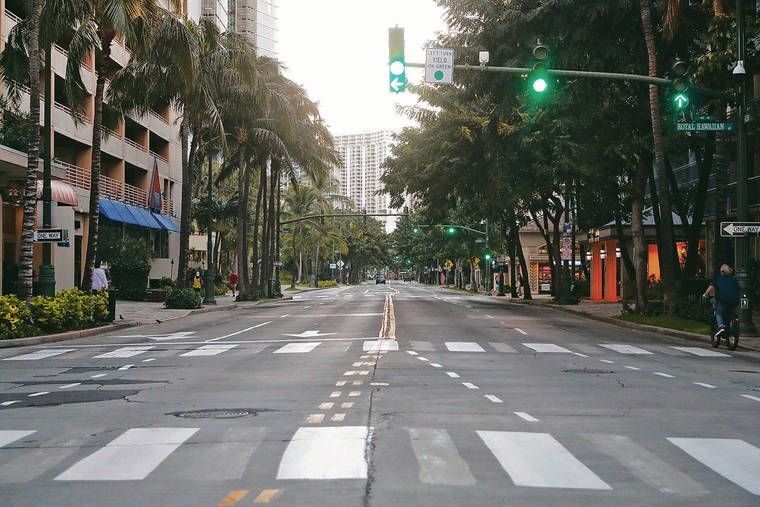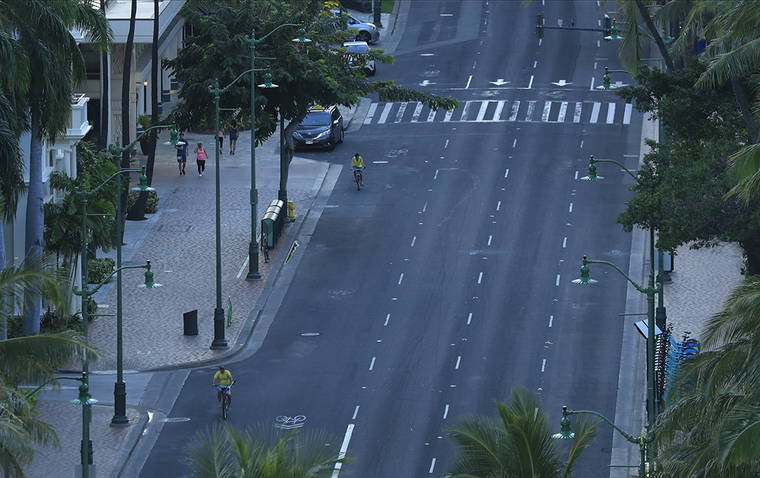Gov. David Ige expects Hawaii stay-home order to be extended beyond April 30

JAMM AQUINO / JAQUINO@STARADVERTISER.COM
Usually a crowded thoroughfare, Kuhio Avenue was nearly free of vehicular traffic Saturday with green lights all the way.

JAMM AQUINO / JAQUINO@STARADVERTISER.COM
Kalakaua Avenue was empty Saturday as the sun set. Gov. David Ige said Monday the stay-at-home mandate will likely be extended past April 30 but that the state is looking at loosening some local restrictions on specific activities.

JAMM AQUINO / JAQUINO@STARADVERTISER.COM
Kalakaua Avenue is seen without any vehicular traffic on Saturday, April 18, 2020 in Waikiki. Hawaii governor David Ige enforced stricter rules for people heading outside and towards the ocean, closing all beach access except to enter and exit.



Gov. David Ige said Monday that Hawaii’s stay-at-home order probably will be extended past April 30, but said the state is looking at loosening some local restrictions on specific activities such as delays in elective surgeries.
Ige said he has been consulting with the four county mayors, and expects to make an announcement before the end of the week on what sort of extension of the stay-home order the state might impose.
“We are looking at and thinking about how can we in phases restore some areas to normal activity,” Ige said during an online interview as part of the Honolulu Star-Advertiser’s COVID-19 Opens in a new tab Care Conversation. “That would help the economy; that would help revenue to government agencies; that would help people maintain their mental health and allow us to sustain the overall social distancing for a longer period of time.”
He added, “We certainly will require all businesses that reopen to implement social distancing guidelines and rules so that we can be certain that the risk of infection is minimized.”
Ige said state and county officials “recognize that the number of cases are coming down, so we’ll be looking at those kinds of categories of different activities to begin to relax some of the restrictions.”
According to data compiled by Johns Hopkins University Opens in a new tab, as of Sunday Hawaii was tied with Montana for the lowest per capita infection rate in the nation for the new corona- virus, and this state been suggested as a location that soon might be able to lift some restrictions on normal activities.
Don't miss out on what's happening!
Stay in touch with breaking news, as it happens, conveniently in your email inbox. It's FREE!
Ige essentially shrugged off a question about protests over the weekend by people who oppose stay-home orders and closures both in Hawaii and elsewhere.
“Everyone is entitled to their opinion,” he said. “We understand that it’s been hard. Last weekend was the fourth weekend of our stay-at-home order, but I really am excited about the fact that so many in our community are really staying home and limiting being out and about.”
Ige also said in the online interview Monday that additional federal support for the states and local governments offers the most promising way for Hawaii to avoid pay cuts or furloughs for the state’s public workers.
“We continue to work with the congressional delegation to really talk about that help, because that would be the best scenario for us to get back to normal as quickly as possible,” he said.
The CARES Act approved by the Congress and President Donald Trump on March 27 will provide $1.25 billion in aid to Hawaii state government and the counties, but Ige has said the state is still confronting a budget shortfall of about $1.5 billion over the next 15 months.
Public worker union leaders said last week the administration proposed a 20% salary cut on most public employees including teachers as early as May 1, and a 10% cut in pay for first responders such as police officers, firefighters, nurses and emergency medical technicians. However, Ige said last week that no final decision has been made on the pay cuts, and no cuts will be implemented until at least June 1.
Ige said Monday that the state anticipates a reduction in revenue for the next six to 18 months and must take steps to reduce spending to bring it more in line with the revenue coming in.
He said the administration already has placed a freeze on purchases and “nonpersonnel expenses,” and lawmakers have said the administration has instructed departments to develop plans to cut their budgets by 10% for the fiscal year that begins July 1.
Ige noted that during 2009 and 2010 — the sluggish years after the Great Recession — the state set up an “environmental corps” conservation program in which the state hired people to work on watershed protection, fencing and other public works projects. “So, certainly we are talking about that as an option,” he said.
He also said the state is looking at supporting farmers with labor as a way to increase food production, but did not offer any specifics.
The state also might hire laid-off workers to help with contact tracing for people who have had contact with people with coronavirus, Ige said.
Experts have said the state will need to launch an extensive testing program as the economy restarts to ensure visitors to Hawaii are not infected with the new coronavirus, but Ige said the state has discovered some problems with the Abbott ID NOW COVID-19 molecular test, which the company says delivers results within 15 minutes Opens in a new tab.
Hawaii received some of the tests, and Ige said that “we’re actually running tests on it, and the 15 minutes is really not running into 15 minutes. It’s really ending up being 20 to 45 minutes per test, and what they don’t talk about is that you can only run one test at a time.”
“If you imagine we get 300 people coming in on an airplane, there’s no way to physically test everybody,” Ige said. “So, we continue to monitor the new testing technologies, and antibody testing or serum testing where we’re taking a drop of blood or something seems to be the best opportunity for a quick result that could be helpful, but that doesn’t exist for COVID-19 right now.”
For the continuing trickle of people who continue to visit Hawaii during the pandemic, Ige said the state is looking at partnering with some hotels to establish a system of certified quarantine locations, and then requiring that visitors complete their required two-week quarantines in one of those certified sites.






